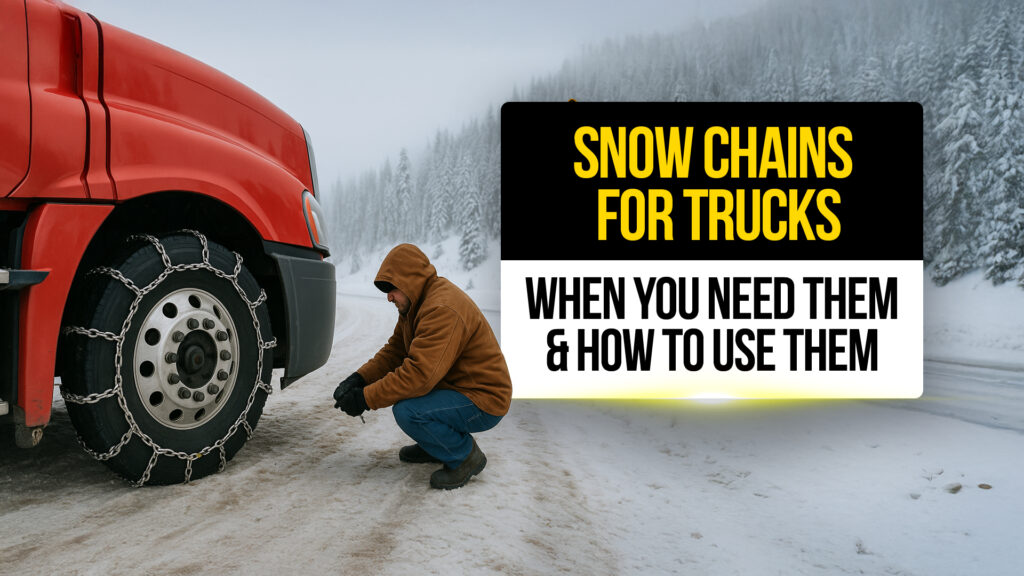
Snow season can turn a regular haul into a real test of skill, and safety. Whether you run the mountains or cross snowy Midwest plains, knowing when and how to use snow chains for trucks isn’t just good practice, it’s the law in many states. In this guide, we’ll break down chain laws by region, installation tips, and how to stay ahead of winter delays. Because the last thing you want is a fine, or worse, a preventable accident.
What’s Really Going On with Snow Chain Rules?
Every year, state DOTs update their chain laws as early as September. Some states like Colorado and California have mandatory chain-up requirements during storms, especially for commercial vehicles over 26,000 lbs.
If you’re heading through these states (or places like Oregon, Washington, or Utah), expect to see chain signs lighting up, often with little warning. Violating those rules? It can cost you hundreds in fines or leave you stuck in a chain-up area waiting it out.
According to the Colorado Department of Transportation, commercial drivers face fines up to $500 for not carrying chains and up to $1,000 if they block the road during a chain-up alert CDOT.
Pros, Cons & What to Watch Out For
Pros of Using Snow Chains:
- Better traction on icy or snow-packed roads
- Helps stay compliant with DOT regulations
- Can prevent serious accidents and cargo damage
- May help reduce insurance issues after a winter-related claim
Cons or Considerations:
- Time-consuming to install if you’re unprepared
- Can damage tires or roads if used on dry pavement
- Not legal in all states when there’s no snow (check local laws)
What to Watch Out For:
- Always carry the right number of chains (usually six for standard semi-trucks)
- Watch your speed, chains are not meant for fast driving (generally under 30 mph)
- Inspect chains for rust, breaks, or missing links before each trip
What It Means for Your Job (or Career Path)
If you’re running OTR in mountain states or winter-prone regions, being chain-compliant is a must. Company drivers are usually expected to carry and know how to use chains; lease ops and owner-operators must ensure their equipment is compliant and ready at all times.
Whether you’re choosing local vs. regional or planning to run west, knowing chain laws helps you avoid costly delays and keeps you off the side of the road with DOT breathing down your neck.
Stuck Sorting Through Snow Routes & Regulations?
That’s exactly why Drivers 1st exists. We’re not here to push you,we’re here to help you make a move when you’re ready. From high-paying routes to lifestyle-friendly jobs, we connect drivers to opportunities that make sense.
How to Take Action or Apply
Tips for Staying Chain-Ready:
- Check state-specific laws before your route (especially CO, CA, OR, WA, ID).
- Practice installing chains before the snow hits, don’t wait until a storm.
- Keep gloves, a flashlight, and a kneeling pad in your rig to make chain-ups easier.
- Inspect your chains monthly during the season for wear and fit.
If you’re tired of guessing which runs are worth it in winter, let us help you find something that fits your lifestyle and skillset.
→ Search CDL Jobs Near You
→ Talk to a Driver Advocate (No Pressure)
Conclusion
Snow chains aren’t just about staying legal, they’re about staying safe and smart in unpredictable winter conditions. Whether you’re running solo or with a company, prepping now can save you a headache (and a paycheck) later.
Your license is your business, make it work for you.
Whether you’re chasing better miles or just need winter-friendly freight, Drivers 1st is here when you are. No pressure. Just better options.
For more updates and insights into the trucking world, stay tuned to Drivers1st.com!
